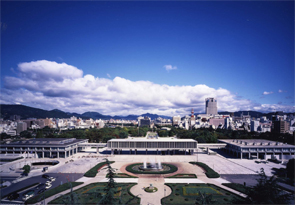
Date of completion
April 1,1954
Established by
Hiroshima City
design
The Park, a joint work by 3 designers, including Kenzo Tange (then assistant professor at Tokyo Univ.), won first prize among 145 works in a design competition.
Shape
Area of the park: approx. 37,000 tsubo(approx. 122,100 m2)
Noteworthy characteristics- Before the A-bombing
- The Dropping of the A-bomb
- Becoming Peace Memorial Park
The neighborhood district of the present-day Peace Memorial Park (Nakajima District) prospered as a point of both land and sea traffic, making it important in the Edo Era. During the Meiji Era, the district became the political, administrative and commercial center, as well as the physical distribution base of Hiroshima, when City Hall and the Prefectural Office were constructed here. The population of the district, with seven towns, was estimated at 6,500 persons at the time of the A-bombing.
The A-bomb, dropped for the first time in the history of humankind on August 6, 1945, exploded over this district. Not only residents of the district, but also many National Militia Unit members and mobilized students, who were engaged in clearing abandoned buildings at the time of the A-bombing, died a violent death, and the cityscape instantly vanished.
Following enactment of the "Hiroshima Peace Memorial City Construction Law" on August 6, 1949, it was decided that this district should be maintained as a peace memorial facility, and the district was reborn as the present-day Peace Memorial Park.
On February 6, 2007, the central axis of the district was designated a place of scenic beauty in Japan. The designated area
was expanded to the entire park on March 28, 2008. It was then the first park of scenic beauty reborn in the post war period.
"Peace Memorial City Construction Law"
This law aims at reconstructing Hiroshima City as a peace memorial city, an ideal symbol in the effort to sincerely realize everlasting peace.